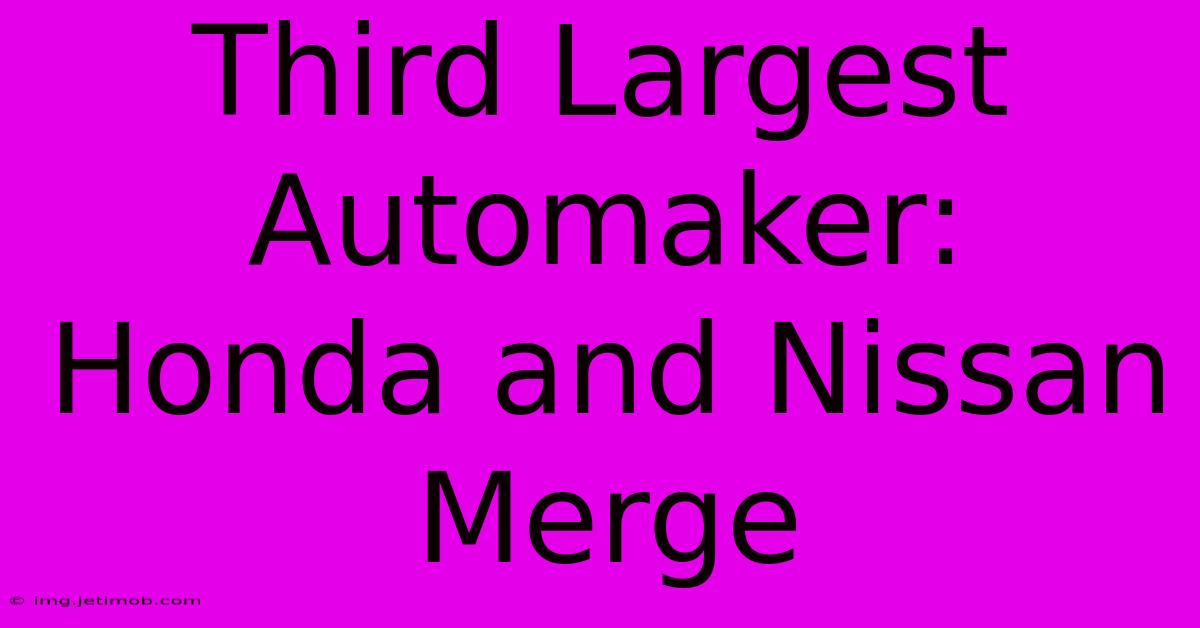Third Largest Automaker: Honda And Nissan Merge

Discover more detailed and exciting information on our website. Click the link below to start your adventure: Visit Best Website. Don't miss out!
Table of Contents
Third Largest Automaker: Honda and Nissan Merge – A Hypothetical Giant
The global automotive landscape is constantly shifting. Alliances, mergers, and acquisitions are commonplace, driven by the need to navigate evolving technologies, tightening emissions regulations, and the ever-increasing pressure of competition. While a merger between Honda and Nissan isn't currently happening, exploring the hypothetical scenario of these two Japanese giants uniting to become the world's third-largest automaker offers fascinating insights into the potential benefits and challenges.
Imagining a Honda-Nissan Mega-Corporation:
The combined might of Honda and Nissan would be truly formidable. Both companies boast significant global market share, strong brand recognition, and established manufacturing capabilities. A merger would create a behemoth rivaling giants like Volkswagen and Toyota, reshaping the automotive industry's power dynamics.
Potential Synergies and Benefits:
- Economies of Scale: Combining research and development, manufacturing, and supply chains would unlock substantial cost savings. Sharing platforms, components, and technologies across a wider range of vehicles would dramatically reduce production expenses.
- Enhanced Global Reach: Honda's strong presence in North America and Nissan's robust footprint in Asia and Europe would create a more geographically diversified company, less susceptible to regional market fluctuations.
- Technological Advancement: Pooling resources would accelerate innovation in electric vehicles (EVs), autonomous driving, and other cutting-edge technologies. The combined expertise of both companies could lead to breakthroughs that neither could achieve independently.
- Increased Market Share: A combined entity could leverage the strengths of both brands to capture a larger market share, potentially surpassing Volkswagen to become the world's second-largest automaker.
- Strengthened Bargaining Power: A larger, more powerful entity would have greater leverage with suppliers, securing better deals and ensuring a more stable supply chain.
Challenges and Potential Hurdles:
Despite the potential benefits, a Honda-Nissan merger would also face significant challenges:
- Cultural Differences: Merging two distinct corporate cultures could be incredibly difficult. Honda is known for its meticulous engineering and focus on quality, while Nissan has a more diverse and sometimes more aggressive approach. Integrating these different approaches could create internal friction and hinder efficiency.
- Brand Identity: Balancing the distinct identities of Honda and Nissan would be crucial. Maintaining the unique appeal of each brand while leveraging the combined strengths requires careful management to avoid alienating loyal customers. A poorly managed merger could dilute brand equity.
- Job Security and Redundancy: Overlapping functions and resources would inevitably lead to job losses. Managing employee concerns and ensuring a smooth transition would be paramount to avoid negative publicity and damage to morale.
- Regulatory Hurdles: Antitrust regulations would need to be carefully navigated. Authorities would scrutinize the merger to ensure it doesn't create a monopoly and harm competition. The process could be lengthy and complex.
- Integration Complexity: Merging two large, complex organizations is a massive undertaking. Effective integration requires meticulous planning, competent leadership, and a clear vision for the future. Failure to integrate effectively could lead to chaos and ultimately undermine the merger's success.
Exploring Specific Areas of Collaboration:
A hypothetical merger opens up numerous avenues for collaboration:
- EV Technology: Honda's expertise in fuel-efficient engines could be combined with Nissan's experience with EVs, particularly their Leaf model. This synergy could lead to the development of highly competitive and innovative electric vehicles.
- Autonomous Driving: Both companies have invested in autonomous driving technologies. A merger would allow them to pool resources and accelerate the development and deployment of self-driving capabilities.
- Supply Chain Optimization: Combining their global supply chains could lead to significant cost savings and improved efficiency. This would be especially beneficial in securing battery supplies for their EV initiatives.
- Shared Platforms: Developing common vehicle platforms would reduce development costs and allow for greater flexibility in producing a wider range of vehicles.
Conclusion: A Hypothetical Giant with Real-World Implications
A hypothetical merger between Honda and Nissan would create a powerful force in the automotive industry. However, realizing the potential benefits requires careful planning and execution. Successfully navigating cultural differences, managing integration challenges, and adhering to regulatory requirements would be crucial to the success of such a massive undertaking. While the chances of this merger happening remain speculative, exploring the possibilities provides a valuable lens through which to examine the ongoing consolidation within the automotive sector and the challenges and opportunities facing global automakers in the years ahead. The resulting hypothetical entity would undoubtedly impact the global automotive landscape significantly, reshaping the competitive landscape and forcing other manufacturers to adapt to a new era of industry giants. The success of such a venture hinges on careful strategic planning, cultural sensitivity, and a clear vision of how to harness the combined strengths of two iconic brands.

Thank you for visiting our website wich cover about Third Largest Automaker: Honda And Nissan Merge. We hope the information provided has been useful to you. Feel free to contact us if you have any questions or need further assistance. See you next time and dont miss to bookmark.
Also read the following articles
| Article Title | Date |
|---|---|
| Predicting Northern Illinois Vs Fresno State | Dec 24, 2024 |
| Biden Commutes Federal Death Row Sentences | Dec 24, 2024 |
| House Finds Evidence Of Gaetz Sex Payments | Dec 24, 2024 |
| Is Nolan Adapting Homers Odyssey | Dec 24, 2024 |
| Hampton And Mikeys Fresno State Niu Prediction | Dec 24, 2024 |
| Storm Damages Santa Cruz Wharf Two Injured | Dec 24, 2024 |
| Nfl Draft Order Browns Climb Again | Dec 24, 2024 |
| Post Game Analysis Saints Vs Packers Mnf | Dec 24, 2024 |
| 76ers Christmas Day Win 111 106 | Dec 24, 2024 |
| What Time Do Target And Walmart Close Christmas Eve | Dec 24, 2024 |
